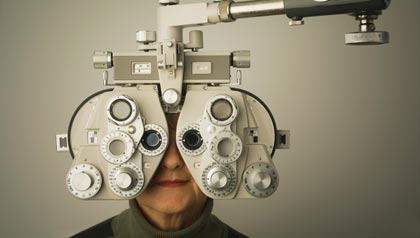Diabetes and Vision Loss
 Diabetes and vision loss can go hand in hand. Vision loss is one of the most common and debilitating complications of diabetes. An annual eye exam will help in early detection of diabetes as for many people with Type 2 Diabetes the disease goes undetected. For those individuals who have been diagnosed as a diabetic, extra attention should be made to monitor their diabetes and have regular eye exams.
Diabetes and vision loss can go hand in hand. Vision loss is one of the most common and debilitating complications of diabetes. An annual eye exam will help in early detection of diabetes as for many people with Type 2 Diabetes the disease goes undetected. For those individuals who have been diagnosed as a diabetic, extra attention should be made to monitor their diabetes and have regular eye exams.
According to Medical News Today, “Diabetes describes a group of metabolic diseases in which the person has high blood glucose (blood sugar), either because insulin production is inadequate, or because the body’s cells do not respond properly to insulin, or both. Patients with high blood sugar will typically experience frequent urination they will become increasingly thirsty and hungry”.
There are three types of diabetes:
- Type 1 Diabetes- account for approximately 10% of all diabetics and occurs when the body doesn’t produce enough insulin. Diabetics generally develop Type 1 Diabetes before their 40th birthday.
- Type 2 Diabetes account for approximately 90% of the remaining diabetics. The body does not produce enough insulin for proper function, or the cells in the body do not react to insulin (insulin resistance). Typically type 2 diabetes is a progressive disease and eventually may lead to medication dependency to control the disease. Overweight and obese people have a much higher risk of developing type 2 diabetes compared to those with a healthy body weight. That’s why diet and exercise play a key role in prevention.
- Gestational Diabetes affects females during pregnancy. Some women have very high levels of glucose in their blood, and their bodies are unable to produce enough insulin to transport all of the glucose into their cells, resulting in progressively rising levels of glucose. Uncontrolled gestational diabetes can raise the risk of complications at childbirth.
Diabetic Eye Disease is a group of eye problems people with diabetes could face as a result of the disease, which can lead to vision loss or blindness. These include:
• Cataract (clouding of the lens of the eye)
• Diabetic retinopathy (the most common form of diabetic eye disease, which damages the blood vessels in the retina)
• Glaucoma (damage to the optic nerve that affects peripheral or side vision)
People often are unaware they have diabetes but In fact, about 90% of diabetes-related blindness is preventable through early detection, timely treatment and appropriate follow-up care. To learn more about diabetes, low vision and vision loss, visit Tri-State Low Vision Services, a division of Bissell Eye Care.
About the author: John D. Bissell, owner of Bissell Eye Care and Tri-State Low Vision Services, offers comprehensive eye examinations for the entire family, ocular disease detection and treatment, eye glasses, sun glasses, active wear, contact lenses, and low vision examinations for those with significant vision loss. He has undergone specialized training for treatment of low vision by the International Academy of Low Vision Specialists utilizing customized telescopic eyeglasses, prisms and telescopic implants for patients who qualify. The practice accepts most types of vision and health insurance plans.

